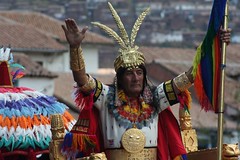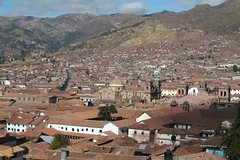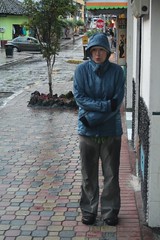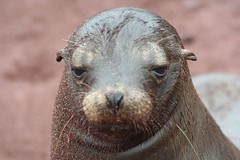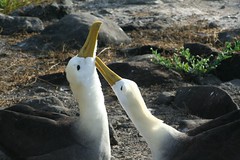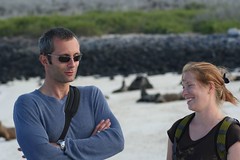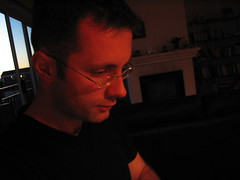The Sacsayhuaman fortress
Click on picture for slide-show
or here to access the set.
For any pleasure traveler to South America Cuzco is a mandatory stop. And therein lies the problem: everyone comes here…
Cuzco is a very pretty high-altitude town with an impressive old center, a mixture of colonial architecture and Inca walls. Often, the colonial houses are built on top of the Inca stonework. With every earthquake, the Spanish houses used to crumble down but their Inca foundations would remain in place, attesting to the far superior building technology of the Andeans. And their stone workmanship is unmatched: blocks of stone of all sizes, from finger-sized pebbles to 50-ton gigantic boulders fit together perfectly with no space in-between, and no mortar was used to hold them together. Seismic resistance is achieved by building at an 8 degree angle (not straight up like the Spanish), by putting the larger stones on top of the smaller, and linking those stone bricks together with bronze keys to make them move as one in case of earthquake. I hope the pictures I took speak more than my words.
Yes, Cuzco is beautiful, but if you are like me and you hate being surrounded by throngs of tourists you’re in the wrong place… Just to give you an idea of how “touristy” this place is, let me tell you that for the last two months, ever since we have started our trip, I’ve been looking for a 58mm polarizing filter for my camera all over Central and South America. I looked in tourist-only areas and in large towns like Quito and Lima, without success; most photography shop employees hadn’t even heard of polarizers. In Cuzco every other shop has them. Regular and circular. All sizes, pick yours…
The Inca reenacted at Inti Raymi
Click on picture to see larger size
On the street, one is always harassed by locals trying to sell you massages, postcards, artwork and tours or to get you into a restaurant, sometimes all of them at the same time. But that’s the least annoying of all… On the old town streets you have a higher chance of bumping into a group of loud 21-year-olds than into a local.
One thing that irritates me beyond sky and earth is the fact that in this town of billions of restaurants, most of them pretty, good and cheap, there’s a place, Jack’s café, which always has a line of white people outside. What the hell makes this restaurant so popular? The food must certainly be good, but it is so in other places as well, and it’s not like you can be a regular customer when you’re a tourist. Is it the fact that the owner is an American and most American tourists would consider an American-managed place safer than locally-owned restaurants – giving in to the unspoken preconceptions that locals are dirty and only a foreigner would know how to keep decent hygiene in the kitchen? Or is it the fact that it’s in the travel books and it’s located in a busy intersection? No idea… anyway, there’s no excuse for the waiting line!
View of Cuzco
Click on picture to see larger size
Of course, I’m being unfair and a hypocrite, because I, as a tourist, am part of the problem. But that doesn’t prevent me from wishing the other tourists the one thing I always wish them: “Stay home, yo!” (in the translated words of my friend Mihai M. who long ago uttered this memorable sentence as we were trying to get on a full bus to a remote village in the mountains of Romania.)
What about us?
Despite the crowds here, we had a good time. But make no mistake, it’s not easy to adapt to 3400 meters of altitude: not even thirty minutes after getting off the plane I have been hit with the worst headache in the history of man, and weak as I was, I was barely able to reach my hotel room and crawl in bed – all this, courtesy of altitude sickness. I woke up 4 hours later feeling worse, if worse had a meaning by then – at least Angela seemed to be better. And then we discovered the miracle cure – “mate de coca” – infusion of coca leaves. Not only it made me feel better, but it immediately took the headache away and poured some fuel in my lifeless legs, enough to make me able to get out of the hostel and explore the town which was happily and colorfully celebrating the ancient Inti Raymi festival of the sun. Coca leaves are a staple around here and it’s no wonder the ancient Incas considered it a sacred plant. I hope the US government, focused on its misguided war on drugs, will never succeed pressuring the government of Peru into outlaw this plant, as they did in Ecuador. But let’s not turn this travel blog into a political forum; I have my other blog for this, although it’s been quite dry over at livejournal since I started this trip...
We met again with Michael and Mor, our friends from the Galapagos, and spent some days together in Cuzco and visiting the Sacred Valley. It was good to see them again. They got fed up with Cuzco fast (for the same reasons as me) and decided to spend a few days in the village of Ollantaytambo, in the Urubamba valley. Hopefully, we’ll meet again in Bolivia and Buenos Aires.
A last bit of trivia about this place: Cuzco, and much of Peru, seems to have been invaded by an army of young Israeli backpackers. More than anywhere else, you hear Hebrew spoken on the street; there are plenty of restaurants with Hebrew-written menus and Israeli food, and the Spanish keyboard at the Internet-café where I’m writing this blog entry has Hebrew characters glued on the keys. We got the drill from Michael and Mor (themselves belonging to the chosen people as well) – apparently, traveling to South America, and more specifically to Peru, has become sort of a rite of passage for young Israelis. As soon as they get out of the army, many spend a few months traveling this continent. The funny thing is that even those who don’t want to or couldn’t care less about traveling do it because of peer pressure…
Well, I still have to meet any Romanians on this trip…
Click here to read more...
Summary only...




